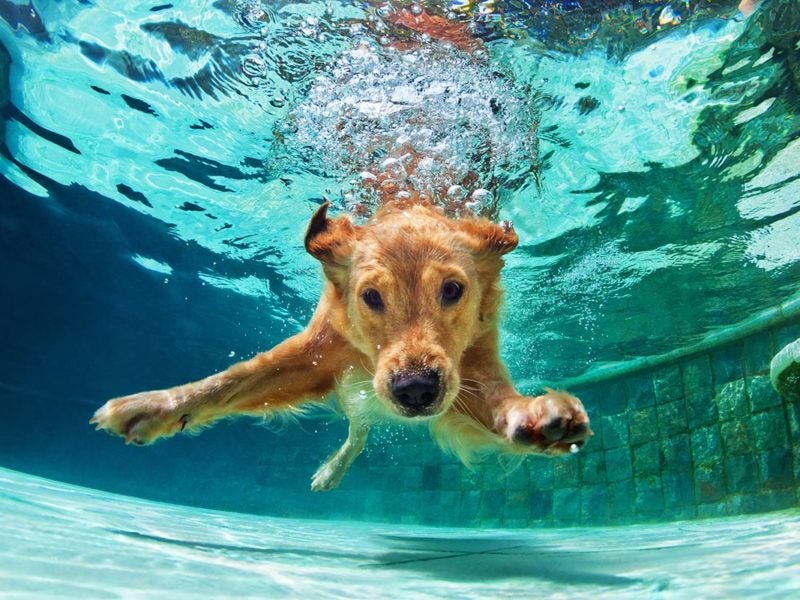Yes, swimming is good for your dog as it is a low-impact exercise that improves cardiovascular health and muscle strength. Additionally, swimming can help with weight management and alleviate joint pain in dogs with arthritis or other mobility issues.
It also provides mental stimulation and can be a fun bonding activity between you and your furry friend. However, it’s important to introduce your dog to swimming gradually and ensure their safety by using life jackets and keeping an eye on them at all times.
Always consult with your veterinarian before starting your dog on any new exercise regimen.
How Swimming Can Improve Your Dog’S Health
Swimming is a beneficial activity for your dog’s health, strengthening muscles and promoting cardiovascular fitness, while being easy on their joints. It’s a natural exercise that can keep them active and help with weight management.
Swimming is not only a fun activity for dogs but also a great way to boost their overall health. Here’s how swimming can benefit your furry friend and contribute to their well-being:
Increases Cardiovascular Fitness:
- Regular swimming sessions can significantly improve your dog’s cardiovascular fitness.
- The water resistance encountered while swimming provides an excellent low-impact workout for their heart and lungs.
- Swimming can help increase their stamina, allowing them to engage in physical activities for longer periods.
Helps With Weight Management:
- Swimming is a fantastic exercise for weight management in dogs who may be overweight or obese.
- The buoyancy of water reduces the stress on joints while still providing an effective workout.
- This low-impact exercise burns calories and helps dogs shed excess pounds, promoting a healthier weight.
Builds Muscle Strength And Endurance:
- Swimming is a whole-body exercise that engages various muscle groups in dogs.
- The resistance of water aids in building muscle strength, particularly in the legs, back, and shoulders.
- By swimming regularly, your dog can develop increased muscle endurance, allowing them to engage in more strenuous activities without easily tiring.
Reduces Joint Stress And Pain:
- For dogs with joint issues such as arthritis, swimming can be an excellent form of therapy.
- Water’s buoyancy minimizes the impact on their joints, reducing pain and discomfort while exercising.
- Swimming improves joint flexibility, helping to alleviate stiffness and maintain mobility in older or arthritic dogs.
Provides Mental Stimulation And Stress Relief:
- In addition to the physical benefits, swimming also provides mental stimulation for your dog.
- The new environment, coupled with the excitement of swimming, engages their senses and keeps their minds active.
- Swimming can also be a great stress-reliever, helping dogs release pent-up energy and reducing anxiety or behavioral issues.
Swimming can be an incredibly beneficial activity for your dog, improving their cardiovascular fitness, aiding in weight management, building muscle strength, reducing joint stress and pain, as well as providing mental stimulation and stress relief. So, next time you’re near a pool or lake, consider taking your furry friend for a swim and watch their health soar!

Credit: www.akc.org
Safety Precautions For Dog Swimming
Swimming can be a beneficial activity for dogs, but it is important to take safety precautions. Always supervise your dog while swimming, use appropriate life jackets, and introduce them gradually to water to ensure a positive and safe experience.
Swimming can be a fun and healthy activity for your furry friend, but it’s essential to take necessary safety precautions to ensure their well-being. Here are some key safety measures to keep in mind:
Choosing A Safe Swimming Location:
- Look for designated dog-friendly swimming areas that have calm waters and minimal boat traffic.
- Avoid areas with strong currents, sharp rocks, or debris that could potentially harm your dog.
- Opt for shallow swimming spots where your dog can touch the bottom with their paws.
Using Life Jackets For Dogs:
- Consider investing in a well-fitting life jacket specifically designed for dogs, especially if your dog is not a strong swimmer or has low buoyancy.
- Life jackets provide additional safety and buoyancy, helping to prevent fatigue and accidents in the water.
Supervising Your Dog While Swimming:
- Never leave your dog unattended while they are swimming, even if they are experienced swimmers.
- Keep a close eye on them to ensure they stay within their comfort zone and don’t venture too far from shore.
- Be aware of any signs of distress or fatigue, such as excessive panting or difficulty staying afloat, and remove them from the water if necessary.
Monitoring Water Quality And Temperature:
- Make sure the water your dog is swimming in is clean and free from pollutants, harmful algae blooms, or excessive bacteria that could cause illnesses.
- Avoid swimming in water bodies with high levels of bacteria, toxic chemicals, or harmful substances.
- Additionally, ensure the water’s temperature is suitable for your dog’s comfort. Extremely cold or hot water can be dangerous.
Preventing Ear Infections In Dogs:
- After swimming, thoroughly dry your dog’s ears to prevent moisture buildup, which can lead to ear infections.
- Use a clean towel and gently wipe the ears, ensuring they are completely dry.
- If your dog is prone to ear infections, consider using veterinarian-recommended ear cleansers to maintain ear hygiene.
Remember, safety should always be a priority when it comes to your dog’s swimming adventures. By following these precautions, you can enhance their enjoyment while minimizing any potential risks. So dive in, have fun, and create lasting memories with your furry companion!
How To Introduce Your Dog To Swimming
Swimming is incredibly beneficial for dogs, as it provides a low-impact workout that helps improve their cardiovascular health, muscle strength, and joint flexibility. Whether you’re introducing your dog to swimming for the first time or just curious about the benefits, swimming can be a great way to keep your furry friend happy and healthy.
Dogs can greatly benefit from swimming as it provides them with exercise, mental stimulation, and a cool way to beat the heat. However, not all dogs are naturally inclined to take a dip in the water. If you want to introduce your furry friend to swimming, follow these steps to ensure a positive and successful experience:
Start In Shallow Water:
- Find a calm and shallow area such as a pool, lake, or beach.
- Choose a location with a gradual incline where your dog can easily enter and exit the water.
- Keep an eye out for any potential hazards such as strong currents or sharp objects.
Use Positive Reinforcement And Treats:
- Begin by gently coaxing your dog towards the water using a cheerful tone of voice.
- Reward your dog with praise and treats for showing interest in the water.
- Use toys or treats to create positive associations with the swimming area.
Gradually Increase Water Depth And Distance:
- Once your dog is comfortable with shallow water, gradually move to deeper areas.
- Slowly lead your dog further into the water, allowing them to adjust at their own pace.
- Be patient and give your dog plenty of breaks to rest and regain confidence.
Teach Basic Swimming Commands:
- Introduce basic commands such as “come” and “stay” to ensure your dog’s safety while swimming.
- Practice these commands on land before moving to the water.
- Use treats and positive reinforcement to reinforce good behavior.
Make Swimming A Fun And Rewarding Experience:
- Engage in water play with your dog to make swimming enjoyable.
- Throw a toy or play fetch in the water to encourage your dog’s participation.
- Remember to always supervise your dog while swimming to ensure their safety.
By following these steps and providing a positive and rewarding experience, you can help your dog become a confident and enthusiastic swimmer. Just remember to take it slow, be patient, and most importantly, have fun together!
Frequently Asked Questions On Is Swimming Good For My Dog?
Faq 1: Can Dogs Go Swimming?
Yes, dogs can go swimming, and it can be an excellent form of exercise for them.
Faq 2: Is Swimming Good For Dogs With Joint Issues?
Swimming is a low-impact exercise, making it a great option for dogs with joint issues, as it reduces stress on their joints.
Faq 3: How Can Swimming Benefit My Dog’S Overall Health?
Swimming can improve your dog’s cardiovascular fitness, promote muscle strength, and enhance their overall endurance.
Faq 4: Can Swimming Help My Dog Cool Down In Hot Weather?
Swimming allows dogs to cool down efficiently, as the water helps dissipate heat from their body, keeping them refreshed and comfortable.
Faq 5: Are There Any Precautions To Consider Before Letting My Dog Swim?
Ensure your dog is comfortable in the water, supervise them at all times, and provide a safe and clean swimming environment for their well-being.
Conclusion
Swimming can be a fantastic activity for dogs, offering a multitude of benefits for their physical and mental well-being. Not only does it provide a refreshing way for them to cool off during hot summer months, but it also serves as a low-impact exercise, reducing strain on joints and muscles.
The buoyancy of water allows dogs to stay active while minimizing the risk of injury, making it particularly beneficial for older or injured pups. Additionally, swimming engages their entire body, helping to build and tone muscle, improve cardiovascular health, and maintain a healthy weight.
Moreover, swimming can have positive effects on a dog’s mental state, as it provides an outlet for them to release energy and reduce anxiety. Overall, introducing your furry friend to swimming can be a wonderful way to enhance their overall health and happiness.
So why not take the plunge with your canine companion and enjoy all the advantages swimming has to offer?
Last Updated on May 10, 2025 by Pauline G. Carter

